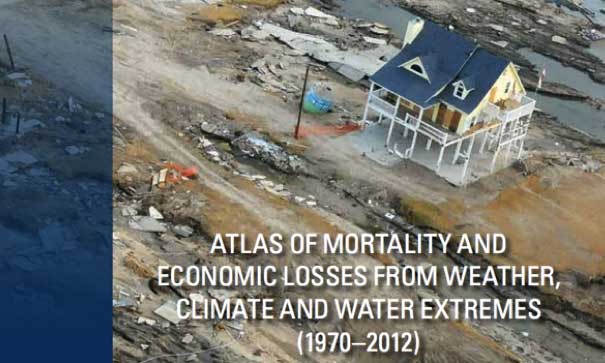Avslutningen av den här artikeln är en kopia av ett pressmeddelande som WMO, World Meteorological Organization, publicerad den 11 juli, 2014. Texten är på engelska. Jag publicerar den för att rapporten sammanställer väsentliga konsekvenser data kring personskador och ekonomiska förluster till följd av väder- och vattenextremer. Pressmeddelandet ger en hint om storleken av det enorma lidandet och de enorma kostnaderna som väderextremer för med sig.
 Nej, det är inte så att väderextremer är ett nytt påfund, givetvis hade det förekommit skyfall och stormar även utan människans inverkan på klimatsystemet. Men vi medverkar till att förändra vädersystemen, hur vatten cirkulerar och en del geologiska förutsättningar. Och det förändrar i sin tur sannolikheterna för att extremer skall inträffa. På en del ställen minskar riskerna och på andra ställen ökar de.
Nej, det är inte så att väderextremer är ett nytt påfund, givetvis hade det förekommit skyfall och stormar även utan människans inverkan på klimatsystemet. Men vi medverkar till att förändra vädersystemen, hur vatten cirkulerar och en del geologiska förutsättningar. Och det förändrar i sin tur sannolikheterna för att extremer skall inträffa. På en del ställen minskar riskerna och på andra ställen ökar de.
Mycket av vår samhällsplanering (infrastruktur, livsmedelsförsörjning, energisystem, försäkringar, juridiska åtaganden mm) baseras på förutsättningar som rådde under 1900-talet. Förutsättningar som sakta men säkert håller på att förändras.
“Sakta” förresten… Sett till våra dagliga liv så kan man föranledas tycka att förändringarna går långsamt. Men i ett geologiskt perspektiv så är vi just nu med om en explosion.
De största ekonomiska konsekvenserna kommer till följd av översvämningar och stormar, medan de största antalet omkomna kommer till följd av värmeböljor. En viss trend finns i att de ekonomiska konsekvenserna är stora i rika länder, medan fler människor dör i fattiga länder. (Detta blir väldigt tydligt tex när samma storm passerar över flera nationer). Men tro inte att det bara är fattiga människor i utvecklingsländer som dör till följd av väderextremer: I Europa uppgick kostnaderna för väderextrmer till 375 miljarder dollar och ca 150.000 människor fick sätta livet till i två värmeböljor: Sydeuropa 2003 samt Ryssland 2010.
Den här artikeln handlar inte så mycket om klimatförändringar som behovet av att anpassa sig och skydda samhället och medborgare för väderextremer, vare sig de är en konsekvens av vår miljöpåverkan eller hade inträffat “i alla fall”.
/Martin
Nedan följer pressmeddelandet från WMO:
Geneva, 11 July 2014 (WMO) – Weather, climate and water-related disasters are on the rise worldwide, causing loss of life and setting back economic and social development by years, if not decades. From 1970 to 2012, 8 835 disasters, 1.94 million deaths, and US$ 2.4 trillion of economic losses were reported globally as a result of hazards such as droughts, extreme temperatures, floods, tropical cyclones and related health epidemics, according to a new report.
The Atlas of Mortality and Economic Losses from Weather, Climate and Water Extremes 1970-2012 describes the distribution and impacts of weather, climate, and water-related disasters and highlights measures to increase resilience. It is a joint publication of the World Meteorological Organization (WMO) and the Centre for Research on the Epidemiology of Disasters (CRED) of the Catholic University of Louvain (UCL) in Belgium.
The Atlas aims to provide decision-makers with actionable information for protecting life and property.
It is also highlights the need for stronger efforts to report, standardize and analyze data on weather, climate, and water-related hazards to improve understanding of disasters and reinforce the platform for prevention.
The report was published ahead of the First Session of the Preparatory Committee Meeting (Geneva 14-15 July) for the Third United Nations World Conference on Disaster Risk Reduction. It seeks to inform debate on the post-2015 framework both for disaster risk reduction and sustainable development.
Storms and floods accounted for 79 per cent of the total number of disasters due to weather, climate and water extremes and caused 55 per cent of lives lost and 86 per cent of economic losses between 1970 and 2012, according to the Atlas. Droughts caused 35 per cent of lives lost, mainly due to the severe African droughts of 1975 and 1983–1984.
The 1983 drought in Ethiopia ranked top of the list of human casualties, claiming 300 000 lives, as did Cyclone Bhola in Bangladesh in 1970. Drought in Sudan in 1984 killed 150 000 people, whilst the Cyclone locally known as Gorky killed 138 866 people in Bangladesh in 1991.
Hurricane Katrina in the United States of America in 2005 caused the worst economic losses, at US$ 146.89 billion, followed by Sandy in 2012 with a cost of $ 50 billion.
The worst ten reported disasters in terms of lives lost occurred primarily in least developed and developing countries, whereas the economic losses were mainly in more developed countries.
“Disasters caused by weather, climate, and water-related hazards are on the rise worldwide. Both industrialized and non-industrialized countries are bearing the burden of repeated floods, droughts, temperature extremes and storms,” said WMO Secretary-General Michel Jarraud.
“Improved early warning systems and disaster management are helping to prevent loss of life. But the socio-economic impact of disasters is escalating because of their increasing frequency and severity and the growing vulnerability of human societies.”
The report highlighted the importance of historical, geo-referenced information about deaths and damages to estimate risks before the next disaster occurs. This information can support practical decisions on reducing potential impacts by, for example, improved early warning systems, retrofitting critical infrastructure, or enforcing new building codes.
“Collecting global loss data that are comparable and complete is a major challenge. Climate and weather services are working with disaster-impact researchers and data centers to meet this challenge. This partnership is producing analyses that support practical decisions on reducing the human consequences of disasters, for example by investing in early warning systems or targeting the most vulnerable communities,” said CRED Director, Prof. Debarati Sapir.
The United Nation’s Global Assessment Report on Disaster Risk Reduction 2013 concluded that direct and indirect losses from natural hazards of all kinds have been underestimated by at least 50 per cent because of the data collection challenges. Because better reporting of disaster impacts is vital for strengthening disaster risk reduction, the international community should help vulnerable countries improve their capacity for developing and maintaining high-quality damage and loss databases.
Another challenge for users of risk information is the changing characteristics (frequency, location, severity) of weather-, climate- and water-related hazards. Natural climate variability is now exacerbated by long-term, human-induced climate change, so that yesterday’s norms will not be the same as tomorrow’s.
The WMO-CRED-Louvain report seeks to raise awareness of these and other challenges to collecting and analyzing disaster risk information. It presents a worldwide analysis of extreme weather, climate and water events drawing on the Emergency Events Database (EM-DAT), compiled by CRED. The Atlas compares the reported impacts of meteorological, climatic and hydrological extremes (as categorized by CRED) on people and economies at both the global and regional levels.
In addition to global statistics and maps, the Atlas also provides details on disasters at the regional level.
Africa: From 1970 to 2012, there were 1 319 reported disasters caused the loss of 698 380 lives and economic damages of US$ 26.6 billion. Although floods were the most prevalent type of disaster (61 per cent), droughts led to the highest number of deaths. The severe droughts in Ethiopia in 1975 and in Mozambique and Sudan in 1983–1984 caused the majority of deaths. Storms and floods, however, caused the highest economic losses (79 per cent).
Asia: Some 2 681 disasters were reported in the 1970–2012 period, causing the loss of 915 389 lives and economic damages of US$ 789.8 billion. Most of these disasters were attributed to floods (45 per cent) and storms (35 per cent). Storms had the highest impact on life, causing 76 per cent of the lives lost, while floods caused the greatest economic loss (60 per cent). Three tropical cyclones were the most significant events, striking Bangladesh and Myanmar and leading to over 500 000 deaths. The largest economic losses were caused primarily by disasters in China, most notably by the 1998 floods.
South America: From 1970 to 2012, South America experienced 696 reported disasters that resulted in 54 995 lives lost and US$ 71.8 billion in economic damages. With regard to impacts, floods caused the greatest loss of life (80 per cent) and the most economic loss (64 per cent). The most significant event during the period was a flood and land and mudslide that occurred in Venezuela in late 1999 and caused 30 000 deaths. This single event skews the loss of life statistics significantly for the entire region.
North America, Central America and the Caribbean reported 1 631 disasters that caused the loss of 71,246 lives and economic damages of US$ 1 008.5 billion. The majority of the reported disasters in this region were attributed to storms (55 per cent) and floods (30 per cent). Storms were reported to be the greatest cause of lives lost (72 per cent) and of economic loss (79 per cent).
The South-West Pacific region experienced 1 156 reported disasters in 1970–2012 that resulted in 54684 deaths and US$ 118.4 billion in economic loss. The majority were caused by storms (46 per cent) and floods (38 per cent). The most significant reported disasters with regard to lives lost were tropical cyclones, mainly in the Philippines, including the event of 1991, which killed 5956 people. The 1981 drought in Australia caused US$ 15.2 billion in economic losses and the 1997 wildfires in Indonesia caused nearly US$ 11.4 billion in losses.
In Europe, 1 352 reported disasters claimed 149 959 lives and caused US$ 375.7 billion in economic damages. Floods (38 per cent) and storms (30 per cent) were the most reported cause of disasters, but extreme temperatures led to the highest proportion of deaths (94 per cent), with 72 210 lives lost during the 2003 western European heat wave and 55 736 during the 2010 heat wave in the Russian Federation. In contrast, floods and storms accounted for most of the economic losses during the period.


